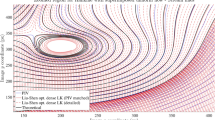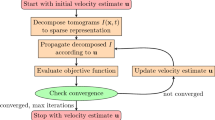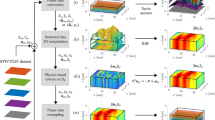Abstract
An experiment on living microorganisms is conducted to gain insight into their motion and fluid exchange characteristics. Biocompatible microscopic particle image velocimetry (PIV)-systems are used to capture images of seeded particles in the induced fluid flows. To enhance the abilities of these devices we present a model-based approach for the reconstruction of admissible flow fields from captured images. A priori knowledge of the physical model of the flow is used to iteratively refine a predicted flow field. A physics-based filter operation generates a velocity field that is consistent with the model of incompressible laminar flows described by the Navier–Stokes equations. Interactive steering of the reconstruction process is achieved by exploiting programmable graphics hardware as a co-processor for numerical computations. To validate our method, we estimate velocity vector fields from synthetic image pairs of flow scenarios for which ground truth velocity fields exist and real-world image sequences of the flow induced by sessile microorganisms.



















Similar content being viewed by others
Notes
The Galerkin property ensures a consistent calculation on different levels of resolution, and thus it guarantees fast convergence of the multigrid scheme.
The reference image R and the template image T correspond to Im t and Im t + 1 with respect to acquisition time t.
The EDPIV software package is available at (http://opticallab.ncpa.olemiss.edu/EdpivPE3_intro.htm).
Ciliate is a sessile microorganism attached via stalk to the surface of granules forming up granular activated sludge. By adjusting the stalk, a ciliate can vary its inclination angle with respect to its initial orientation. This motion is referred to as nodding motion (Hartmann et al. 2007).
According to the observations in nature, the largest velocity magnitudes are expected in the vicinity of the oral cavity of the microorganism.
References
Blake JR (1982) Mechanics of ciliary transport. Cell Motil Cytoskeleton 2(S1):41–45
Blake JR (2001) Microbiological fluid mechanics: a tribute to Sir James Lighthill. Math Methods Appl Sci 24:1469–1483
Blake JR, Otto SR, Blake DA (1998) Filter feeding, chaotic filtration and a blinking stokeslet. Theor Comput Fluid Dyn 10(1):23–36
Bruhn A, Weickert J, Feddern C, Kohlberger T, Schnörr C (2005) Variational optical flow computation in real-time. IEEE Trans Image Process 14(5):608–615
Carlier J, Wieneke B (2005) Report 1 on production and diffusion of fluid mechanics images and data, fluid project deliverable 1.2. European Project “Fluid image analysis and description” (FLUID). http://www.fluid.irisa.fr/
Corpetti T, Mémin E, Pérez P (2000) Estimating fluid optical flow. In: 15th International conference on pattern recognition, vol 3, pp 1045–1048
Corpetti T, Heitz D, Arroyo G, Mémin E, Santa-Cruz A (2005) Fluid experimental flow estimation based on an optical-flow scheme. Exp Fluids 40(1):80–97
Gupta S, Prince J (1996) Stochastic models for div-curl optical flow methods. Signal Proc Lett 3(2):32–34
Hackbusch W (1994) Iterative solutions of large sparse systems of equations. Springer, New York
Hartmann C, Özmutlu O, Petermeier H, Fried J, Delgado A (2007) Analysis of the flow field induced by the sessile peritrichous ciliate Opercularia asymmetrica. J Biomech 40(1):137–148
Horn B, Schunck B (1981) Determining optical flow. Artif Intell 17:185–203
Kalmoun EM, Rüde U (2003) A variational multigrid for computing the optical flow. In: Vision, modeling, and visualization conference, pp 577–584
Kowalczyk W, Zima BE, Delgado A (2007) A biological seeding particle approach for μ-PIV measurements of a fluid flow provoked by microorganisms. Exp Fluids 43(1):147–150
Krüger J, Westermann R (2003) Linear algebra operators for GPU implementation of numerical algorithms. ACM Trans Graph 22(3):908–916
Krüger J, Kiefer P, Kondratieva P, Westermann R (2005) A particle system for interactive visualization of 3D flows. IEEE Trans Vis Comput Graph 11(6):744–756
Liron N (1982) Ciliary fluid transport: theory and experiment. Cell Motil Cytoskeleton 2(S1):47–51
Liron N, Blake JR (1981) Existence of viscous eddies near boundaries. J Fluid Mech 107:109–129
Mayer S (2000) Numerical simulation of flow fields and particle trajectories in ciliary suspension feeding. Bull Math Biol 62(6):1035–1059
Mémin E, Pérez P (1998) A multigrid approach for hierarchical motion estimation. In: International conference on computer vision, pp 933–938
Modersitzki J (2004) Numerical methods for image registration. Oxford University Press, New York
Nakajima Y, Inomata H, Nogawa H, Sato Y, Tamura S, Okazaki K, Torii S (2003) Physics-based flow estimation of fluids. Pattern Recognit 36(5):1203–1212
Nobach H, Tropea C (2005) Improvements to PIV image analysis by recognizing the velocity gradients. Exp Fluids 39(3):614–622
Nobach H, Ouellette NT, Bodenschatz E, Tropea C (2005) Full-field correlation-based image processing for PIV. In: 6th International symposium on particle image velocimetry
Otto SR, Yannacopoulos AN, Blake JR (2001) Transport and mixing in Stokes flow: the effect of chaotic dynamics on the blinking stokeslet. J Fluid Mech 430:1–26
Owens JD, Luebke D, Govindaraju N, Harris M, Krüger J, Lefohn AE, Purcell TJ (2007) A survey of general-purpose computation on graphics hardware. In: Computer Graphics Forum, vol 26, pp 80–113
Petermeier H, Kowalczyk W, Delgado A, Denz C, Holtmann F (2007) Detection of microorganismic flows by linear and nonlinear optical methods and automatic correction of erroneous image artefacts and moving boundaries in image generating methods by a neuronumerical hybrid implementing the Taylor’s hypothesis as a priori knowledge. Exp Fluids 42(4):611–623
Quenot GM, Pakleza JD, Kowalewski TA (1998) Particle image velocimetry with optical flow. Exp Fluids 25(3):177–189
Raffel M, Willert CE, Kompenhans J (2001) Particle image velocimetry: a practical guide, 2nd edn. Springer, Heidelberg
Ruhnau P, Schnörr C (2007) Optical stokes flow estimation: an imaging-based control approach. Exp Fluids 42(1):61–78
Ruhnau P, Kohlberger T, Schnörr C, Nobach H (2005) Variational optical flow estimation for particle image velocimetry. Exp Fluids 38(1):21–32
Scarano F (2002) Iterative image deformation methods in PIV. Meas Sci Technol 13(1):R1–R19
Sládecek V (1981) Indicator value of the genus Opercularia (Ciliata). Hydrobiologia 79(3):229–232
Stam J (1999) Stable fluids. In: 26th annual conference on computer graphics and interactive techniques, pp 121–128
Utz LRP (2003) Identification, life history, and ecology of peritrich ciliates as epibionts on calanoid copepods in the Chesapeake Bay. PhD thesis, University of Maryland
Westerweel J (1993) Digital particle image velocimetry: theory and application. PhD thesis, Delft University of Technology
Willert C, Gharib M (1991) Digital particle image velocimetry. Exp Fluids 10(4):181–193
Zaleski M, Claps C (2001) First record of some peritrichs ciliates for San Miguel del Monte pond (Buenos Aires, Argentina). Gayana (Concepc) 65(1):27–36
Acknowledgments
The authors thank Dominique Heitz and Professor Etienne Mémin for providing the Lamb–Oseen vortex flow dataset. Support by the Deutsche Forschungsgemeinschaft (DFG) within the priority program “Bildgebende Messverfahren in der Strömungsmechanik” (http://www.spp1147.tu-berlin.de) is gratefully acknowledged.
Author information
Authors and Affiliations
Corresponding author
Rights and permissions
About this article
Cite this article
Kondratieva, P., Georgii, J., Westermann, R. et al. A real-time model-based approach for the reconstruction of fluid flows induced by microorganisms. Exp Fluids 45, 203–222 (2008). https://doi.org/10.1007/s00348-008-0472-x
Received:
Revised:
Accepted:
Published:
Issue Date:
DOI: https://doi.org/10.1007/s00348-008-0472-x




